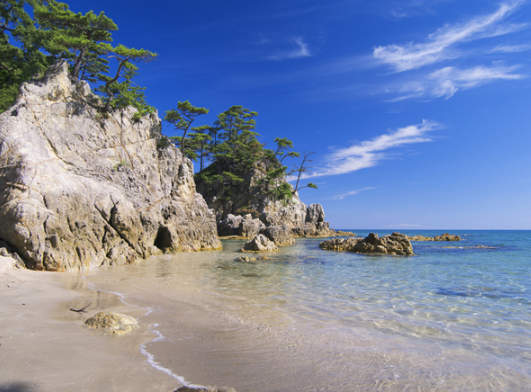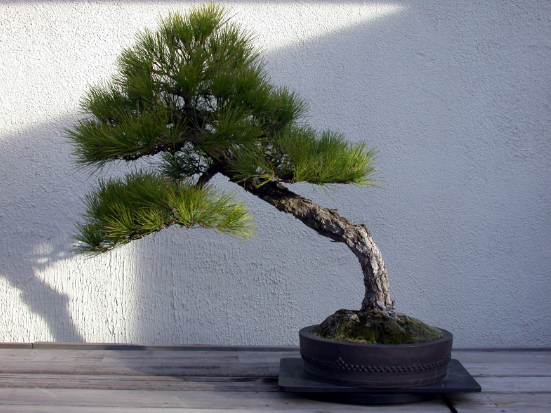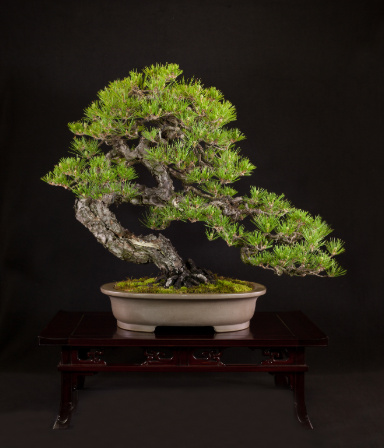Enjoy this new blog column, Species Spotlight, from our First Curator’s Assistant, Andy Bello. Be sure to check out more from Andy on our blog with his Historical Tree Spotlights.
Japanese Black Pines growing on rocks in a coastal environment (https://www.chushikokuandtokyo.org/spot_52/)
Japanese black pines (P. thunbergii) are native to the coastal areas of Japan and South Korea, from sea level to about 3,000 feet of elevation. The trees prefer warm moist climates, where they rarely suffer frost. In Japan, the pine has been highly valued for centuries as an ornamental feature in Japanese-style gardens and for bonsai. Japanese black pines are hardy to U.S. Department of Agriculture Zone 6, but the trees can be kept in colder conditions if proper winter protection is provided.
The National Bonsai and Penjing Museum is a wonderful location to experience Japanese black pines as bonsai and penjing. This species is widely used across the world as artistically-trained potted trees, and the many different shapes these trees take are influenced by cultural and personal experiences. Here we will examine and discuss three Japanese black pines that are on display in the Japanese, North American and Chinese collections.
This first Japanese black pine, displayed in the Japanese Pavilion, was part of the original Bicentennial gift to the American people in 1976. Donated by Goro Ito and in training since 1906, this tree was collected from the wild on the Atsumi Peninsula, located in the Aichi Prefecture. The pine is a beautiful representation of the coastal environment of its origin, mixed with the traditional Japanese bonsai form. Coastal trees tend to flaunt wider upper canopies than trees growing in alpine environments where snow accumulation on branches creates a more narrow, conical form.
This bonsai’s curved trunk suggests an aged tree that has survived strong coastal winds and typhoons. The asymmetrical triangular form of the foliage mass demonstrates the traditional Japanese bonsai style.
The next Japanese black pine is located in the North American Collection and was donated by George Yamaguchi in 1990. Yamaguchi grew this tree from a seed and has been training the pine since 1955. It is styled as a formal upright bonsai and is known by the name “Shinsei,” meaning “Voice of the Gods.” To me, this tree represents a lone pine growing in a meadow at higher elevation. The strong and numerous branches lower on the trunk indicates that the tree had little to no competition from other trees, in contrast to a pine growing in a forest where lower branches are lost due to lack of light. The overall conical shape of the branches suggests a tree subjected to snowfall at higher elevations.
This particular tree is a great example of the influence of Japanese bonsai style in North America. The lower right branch establishes the tree’s asymmetrical form, and the foliage pads on each branch are distinctly separated. North American bonsai, very similar to North American culture, are extremely diverse. Thanks to this diversity, there is no right or wrong way to represent the form of a tree in miniature.
Dr. Yee-sun Wu donated this Japanese black pine, now part of the Chinese Collection, in 1986. The pine has been in training since 1936, but the tree’s origin is unknown. This tree’s style differs greatly from our previously discussed trees. The dramatic movement in the trunk line guides the viewer's eyes up into the foliage mass. The long primary branch, a feature of the “Lingnan” style of penjing common in Southern China, extends dramatically to the right, presenting a strong sense of movement. Penjing, especially in the case of this tree, tend to be more whimsical in their form than Japanese bonsai. The foliage pads are still present but typically are not as “clean cut” as foliage pads on Japanese bonsai.
Penjing can take many forms other than simply a miniature tree – the trees can be shaped into animal forms, cylygrophy, landscapes and more. For more on penjing, read our interview with bonsai master Qingquan Zhao.







